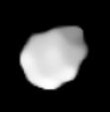Astronomy:354 Eleonora
 | |
| Discovery | |
|---|---|
| Discovered by | Auguste Charlois |
| Discovery date | 17 January 1893 |
| Designations | |
| (354) Eleonora | |
| Pronunciation | /ɛliəˈnɔːrə/[1] |
| 1893 A | |
| Minor planet category | Main belt |
| Adjectives | Eleonorian |
| Orbital characteristics[2] | |
| Epoch 31 July 2016 (JD 2457600.5) | |
| Uncertainty parameter 0 | |
| Observation arc | 123.16 yr (44983 d) |
| |{{{apsis}}}|helion}} | 3.1188 astronomical unit|AU (466.57 Gm) |
| |{{{apsis}}}|helion}} | 2.47676 AU (370.518 Gm) |
| 2.79777 AU (418.540 Gm) | |
| Eccentricity | 0.11474 |
| Orbital period | 4.68 yr (1709.3 d) |
| Mean anomaly | 123.762° |
| Mean motion | 0° 12m 38.196s / day |
| Inclination | 18.403° |
| Longitude of ascending node | 140.37° |
| 5.5215° | |
| Physical characteristics | |
| Dimensions | c/a = 0.75±0.08[3] |
| Mean diameter | 165±3 km[3] 155.17±8.5 km[2] 154.3±5.6 km[4] |
| Mass | (7.5±2.7)×1018 kg[3] (7.18±2.57)×1018 kg[4] |
| Mean density | 3.18±1.14 g/cm3[3] 3.73±1.39 g/cm3[4] |
| Rotation period | 4.277 h (0.1782 d) |
| Geometric albedo | 0.172[3] 0.1948±0.023 |
| S | |
| Absolute magnitude (H) | 6.44 |
Eleonora (minor planet designation: 354 Eleonora) is a large, stony main-belt asteroid that was discovered by the French astronomer Auguste Charlois on January 17, 1893, in Nice.[5]
Photometric observations of this asteroid gave a light curve with a period of 13.623 hours. The data was used to construct a model for the asteroid, revealing it to be a regular-shaped object, spinning about a pole with ecliptic coordinates (β, λ) = (+20°, 356°), although this is with an accuracy of only ±10°. The ratio of the major to minor axes lengths is roughly equal to 1.2.[6] It is classified as an S-type asteroid and has an estimated size of 154.34 km.[4] The spectrum of 354 Eleonora reveals the strong presence of the mineral olivine, a relatively rarity in the asteroid belt.[7]
During favorable oppositions, such as in 1968 and 2010, Eleonora can reach an apparent magnitude of +9.31.
References
- ↑ Eleonora (3rd ed.), Oxford University Press, September 2005, http://oed.com/search?searchType=dictionary&q=Eleonora (Subscription or UK public library membership required.)
- ↑ 2.0 2.1 Yeomans, Donald K., "354 Eleonora", JPL Small-Body Database Browser (NASA Jet Propulsion Laboratory), https://ssd.jpl.nasa.gov/sbdb.cgi?sstr=354, retrieved 11 May 2016.
- ↑ 3.0 3.1 3.2 3.3 3.4 P. Vernazza et al. (2021) VLT/SPHERE imaging survey of the largest main-belt asteroids: Final results and synthesis. Astronomy & Astrophysics 54, A56
- ↑ 4.0 4.1 4.2 4.3 Carry, B. (December 2012), "Density of asteroids", Planetary and Space Science 73 (1): 98–118, doi:10.1016/j.pss.2012.03.009, Bibcode: 2012P&SS...73...98C. See Table 1.
- ↑ "Numbered Minor Planets 1–5000", Discovery Circumstances (IAU Minor Planet center), https://www.minorplanetcenter.net/iau/lists/NumberedMPs000001.html, retrieved 2013-04-07.
- ↑ Kaasalainen, M. et al. (October 2002), "Models of Twenty Asteroids from Photometric Data", Icarus 159 (2): 369–395, doi:10.1006/icar.2002.6907, Bibcode: 2002Icar..159..369K.
- ↑ Burbine, T. H. et al. (July 2000), "The Nature of Olivine Asteroids", Meteoritics & Planetary Science 35: pp. A35, doi:10.1111/j.1945-5100.2000.tb01796.x, Bibcode: 2000M&PSA..35R..35B.
External links
- 354 Eleonora at AstDyS-2, Asteroids—Dynamic Site
- 354 Eleonora at the JPL Small-Body Database
 |

